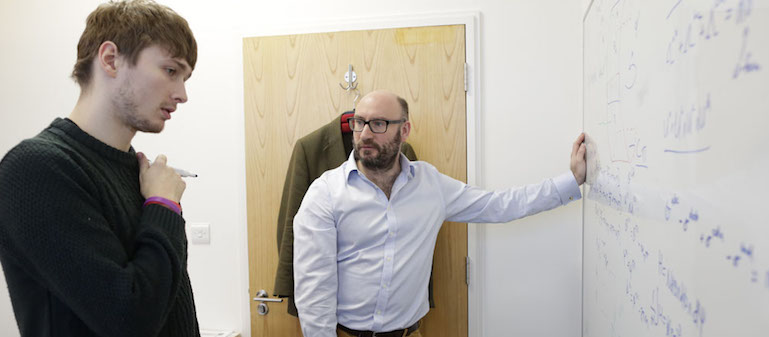
A substantial part of your final year will be taken up by research project work. This project will be chosen from a large range of high level, open ended research topics, developed by our academic staff so as to be closely aligned with their own research interests. You will be supervised by an academic member of staff who is an expert in your chosen field.
The project is a great way to further your interest and specialism in a physics or astronomy topic (projects will be allocated according to your preference where possible). It's a also a fantastic way of improving the research skills, time management, writing ability and independent problem solving that will prepare you for a graduate career or further study.
All BSc projects make up 30 of the total 120 credits of the third year. All MSci projects are more in-depth and make up 45 of the total of 120 credits of the fourth year. Project choice must be linked to the degree programme and some projects have module pre-requisites.
A small selection of the previously available projects are listed below for illustrative purposes. The availability of projects varies year on year.
Example research project abstracts
Capture of carbon dioxide using porous crystalline materials (BSc project)
One critically important environmental problem for modern societies is that of controlling the mount of CO2 we put into the environment. One solution is to capture CO2 at the industrial sources. Current methods are expensive, and there is a lot of interest in looking for new materials for this task. One approach is to use porous crystalline materials, with a lot of interest in hybrid metal-organic materials that form crystal structures that contain large pores and channels. The project is to use computer simulations to understand the mechanisms of CO2 absorption in materials. The approach is to use a technique called molecular dynamics, which is a form of virtual reality at atomic length and time scales. The project will involve setting up a simulation of passing gases across a sample and observing the way that the material soaks carbon dioxide out of the gas stream. The project will require simulations over a range of temperatures and for a range of gas compositions, and will focus on both the capture of CO2 and it subsequent release. The end result will be an evaluation of a specific type of material for capture of CO2, which can be published as a scientific paper.
Beyond the Standard Model Higgs at the LHC (MSci project)
Though the Higgs boson discovered by the LHC in 2012 looks, with current measurements, very much like that predicted by the standard model of Particle physics, this does not rule out richer theories with multiple Higgs bosons where only one of them looks like that predicted in the standard model. This project will identify kinematic variables to distinguish between standard model Higgs production, Higgs production in multi Higgs doublet models and standard model background processes. It involves programming in C++ to run event generators based on Monte-Carlo simulation techniques and simple analysis with the ROOT software.
Black hole physics (BSc/Msci project)
One of the most fascinating objects predicted by Einstein's theory of General Relativity (GR) are black holes and a complete understanding of the quantum physics of black holes remains a challenge for theoretical physics. This project will introduce the student to the basic concepts of black holes, starting with their classical description in terms of solutions of Einstein's equation and a study of geodesic motion in curved backgrounds, moving on to the quantum description and the thermodynamics of black holes. Depending on time the student will study (some of) the following topics:
1) experimental evidence for the existence of black holes
2) Hawking radiation as a quantum mechanical tunnelling effect
3) thermodynamics of black holes in Anti-de-Sitter (AdS) space
4) gravitational waves
Confident detection of super-Earths around nearby stars using Doppler spectroscopy (BSc project)
In the last 20 years, most extra-solar planet candidates have been found using Doppler spectroscopy. After years of technical improvements, Doppler precision is now sufficient to detect planets down to a few Earth-masses in the habitable zone of nearby stars. Confident detection of such small signals requires a good understanding of all sources of noise (random, instrumental, activity induced) and how to include them in the model of the data. The performance of Bayesian, spectral and other data analysis methods will be compared using real and simulated data-sets. This project involves writing and running codes to i) analyze new and archival spectra from the HARPS spectrograph, ii) perform Bayesian Monte Carlo Markov Chain analyses of time-series.

